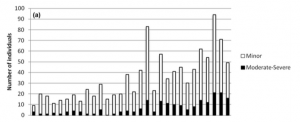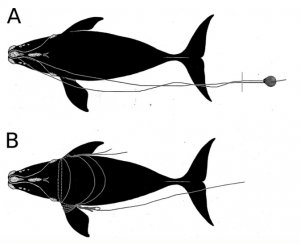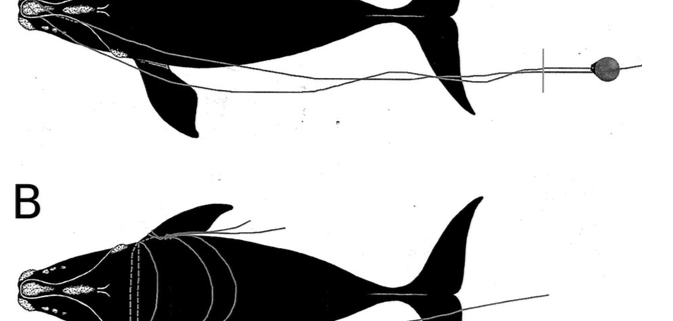North Atlantic right whales and the dangers and effects of entanglement
By Haley Kilgour, SRC intern
Mysticetes (baleen whales) arguably fall under the category of charismatic marine megafauna, capable of drawing the public’s attention to their conservation concern. However, many species are in quite a bit of trouble. Injury and mortality from entanglement with fishing gear is a problem that affects whales worldwide (Knowlton et al, 2016). It is perhaps one of the greatest concerns for the North Atlantic right whale, and is the second largest leading cause of death (Knowlton and Kraus, 2001). With only about 500 individual North Atlantic right whales left (Stills, 2017), conservation is urgently required to ensure the survival of the species.

Number of North Atlantic right whales with minor or moderate-severe entanglements (Knowlton et al, 2016).
Much of the conservation for these whales surrounds lessening the amount of entangled gear on the whales that have already been entangled and lessening the amount of gear in which they may get entangled. Thus far, the United States has had limited success (Stills, 2017) and observed deaths of both right and humpback whales have exceeded the potential biological removal levels defined by the United States government (Knowlton et al, 2016). Figure 1 depicts the increasing number of North Atlantic right whales that are becoming entangled. While minor entanglements make up the majority of entanglements, the increasing number of moderate-severe entanglements is also increasing. With so few individuals remaining, every death is devastating. Deaths from entanglement are caused from instantaneous drowning, delayed death from impaired feeding, increased energy demands due to the drag of gear, and stress (Knowlton et al, 2016). Figure two shows in depiction A) a whale that would experience impeded feeding and in depiction B) a whale that would experience increased swimming efforts due to the drag of gear. Pettis et al (2014) found that stress responses to entanglement can affect the health of a whale even after gear has been removed. Van der Hoop et al (2013) found that entangled gear increased the power requirements of North Atlantic right whales by 70-102%.

Two possible configuration of gear on entangled North Atlantic right whales. Dashed lines are used to depict line on the underside of the animal (Van der Hoop et al, 2016).
The current efforts have focused on the reduction of rope within the water column (Knowlton et al, 2016). Knowlton et al (2016) studied the effects of fishing rope strength on large baleen whales, focusing on North Atlantic right whales and humpback whales. The purpose of the study done by Knowlton et al (2016) was to analyze the properties of ropes removed from whales and to examine rope characteristics in relation to species, age, and injury severity. Knowing rope deterioration rate and breaking strength is important because a certain amount of drag from entangled gear can be used by a whale to free itself (Van der Hoop et al, 2016), thus this knowledge can be used to create reduced breaking strength ropes that can effectively be used for fishing but will lessen the morality of large baleen whales.
Gear samples analyzed in this study were recovered by the Atlantic Large Whale Disentanglement Network, with most samples being taken from free-swimming or anchored entangled whales (Knowlton et al, 2016). The gear was assessed for the following characteristics: diameter, material and fiber type, condition, estimated breaking strength, and strength of a new rope of the same type and diameter (Knowlton et al 2016). The severity of entanglement and the configuration of the gear, for the most part, were assessed by photographs (Knowlton et al, 2016).
Per each whale used in this study, there was an average of 1.83 ropes and the condition of the rope for the majority of cases was classified as good to very good (Knowlton et al, 2016). The average breaking strength of rope entangling a North Atantic right whales was 19.30 kN, for humpback whales was 17.13 kN, and for minke whales was 10.47 kN (Knowlton et al, 2016). Knowlton et al (2016) found no adult North Atlantic right whales entangled in ropes below a breaking strength of 20.02 kN, which suggests that they can break free or disentangle themselves from the weaker ropes.
Several of the most dangerous aspects of entanglements for whales are infections caused by the rope cutting into their bodies, increased demands in energy requirements of swimming, and restricted feeding (Van der Hoop et al, 2016). Knowlton et al (2016) suggest that the use of reduced breaking strength rope could reduce mortality. While entanglements may not be prevented, the stress and numbers of mortality could lessen if ropes are easier for the whales to break free from. Knowlton et al (2016) do note that reduced breaking strength ropes would not prevent lethal entanglements in some areas such as calving grounds. Thus a conservation plan that reduces gear on already entangled whales, reduces the amount of gear in the water, and enforces use of reduced breaking strength ropes will be the most effective.
Works Cited
Hoop, Julie M. Van Der, et al. “Drag from fishing gear entangling North Atlantic right whales.” Marine Mammal Science, vol. 32, no. 2, Sept. 2015, pp. 619–642.
Hoop, Julie Van Der, et al. “Behavioral impacts of disentanglement of a right whale under sedation and the energetic cost of entanglement.” Marine Mammal Science, vol. 30, no. 1, 2013, pp. 282–307.
Amy Knowlton, and Scott Kraus. “Mortality and serious injury of northern right whales (Eubalaena glacialis) in the western North Atlantic Ocean.” Journal of Cetacean Research Management, no. 2, 2001, pp. 193–208.
Knowlton, Amy R., et al. “Effects of fishing rope strength on the severity of large whale entanglements.” Conservation Biology, vol. 30, no. 2, Jan. 2015, pp. 318–328.
Pettis, Heather M, et al. “Visual health assessment of North Atlantic right whales (Eubalaena glacialis) using photographs.” Canadian Journal of Zoology, vol. 82, no. 1, 2004, pp. 8–19.
Stills, Jennifer, editor. “North Atlantic right whales in danger.” Science, 10 Nov. 2017, pp. 730–731.




Leave a Reply
Want to join the discussion?Feel free to contribute!